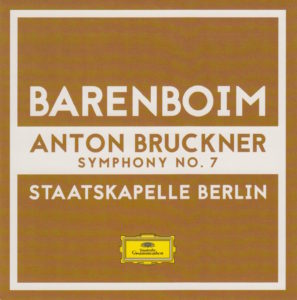 This morning, as we here in West Michigan enjoy a rare mid-April snow shower (we were supposed to get 4″-8″ of the nasty stuff; thankfully, that storm center appears to have missed us), I am listening to Anton Bruckner’s Symphony No. 7 in E Major (WAB 107) interpreted by Argentine-born pianist and conductor Daniel Barenboim (1942-), whom I saw conduct the Staatskapelle Berlin in a performance of Bruckner’s Eighth at Carnegie Hall on January 28th of this year. (I’ll never stop bragging about that. It was one of the highlights of my life.)
This morning, as we here in West Michigan enjoy a rare mid-April snow shower (we were supposed to get 4″-8″ of the nasty stuff; thankfully, that storm center appears to have missed us), I am listening to Anton Bruckner’s Symphony No. 7 in E Major (WAB 107) interpreted by Argentine-born pianist and conductor Daniel Barenboim (1942-), whom I saw conduct the Staatskapelle Berlin in a performance of Bruckner’s Eighth at Carnegie Hall on January 28th of this year. (I’ll never stop bragging about that. It was one of the highlights of my life.)
NOTE: I have two Barenboim CD box sets for this leg of my Bruckner journey. The first (which I call the “Blue Box”) is on the Warner Classics label. The second (which I call the “Pink Box”) is on the Deutsche Grammophon label. The performances in the Blue Box were recorded in the 1990s. The performances in the Pink Box were recorded much more recently, 2012 and 2010.
So…alpha by conductor, then chronological by years recorded.
That’s the plan.
Because today’s recording comes from the Pink Blox, Barenboim’s orchestra for this performance is the Staatskapelle Berlin. And the music label is Deutsche Grammophon, one of my all-time favorite labels for Classical music.
If you want to know what I thought of Maestro Barenboim’s interpretation of Bruckner’s First with Staatskapelle Berlin (“Pink Box”) in this leg of my journey, visit Day 2.
If you want to know what I thought of Maestro Barenboim’s interpretation of Bruckner’s Second with Staatskapelle Berlin (“Pink Box”) in this leg of my journey, visit Day 7.
If you want to know what I thought of Maestro Barenboim’s interpretation of Bruckner’s Third with Staatskapelle Berlin (“Pink Box”) in this leg of my journey, visit Day 12.
If you want to know what I thought of Maestro Barenboim’s interpretation of Bruckner’s Fourth with Staatskapelle Berlin (“Pink Box”) in this leg of my journey, visit Day 18.
If you want to know what I thought of Maestro Barenboim’s interpretation of Bruckner’s Fifth with Staatskapelle Berlin (“Pink Box”) in this leg of my journey, visit Day 26.
If you want to know what I thought of Maestro Barenboim’s interpretation of Bruckner’s Sixth with Staatskapelle Berlin (“Pink Box”) in this leg of my journey, visit Day 34.
If you don’t want to know about those previous performances, keep reading.
In my previous exploration of Bruckner conductors (144 Days With Bruckner And Me), I established a system whereby I posted the objective information first. Then “rated” what I was hearing and reading at the end.
That’s how I’ve been doing it this time around, too.
I won’t go into great detail, but I do want to point out again that thanks to the information in the “Pink Box” I discovered two things about Daniel Barenboim that I didn’t know before:
1. He started a music label called Peral Music, which bills itself as “For the thinking ear.” It’s a very fine web site, with a lot of music, books, and DVDs featured on it.
2. He’s an author. Once I discovered that, I bought two of his books, one I’ve already started reading called Everything Is Connected: The Power of Music.
And now it’s time for the objective stats about today’s performance:
 Bruckner’s Symphony No. 7 in E Major (WAB 107), composed 1879–1881
Bruckner’s Symphony No. 7 in E Major (WAB 107), composed 1879–1881
Daniel Barenboim conducts
Barenboim used the “Leopold Nowak rev. edition, 1954,” according to the liner notes
Staatskapelle Berlin plays
The symphony clocks in at 65:42
This was recorded in Berlin, Germany, in June of 2010
Barenboim was 68 when he conducted it
Bruckner was 59 when he finished composing it
This recording was released on the Peral Music label (licensed to Deutsche Grammophon)
Bruckner wrote his symphonies in four movements. The time breakdown of this one (Symphony No. 7 in E Major), from this particular conductor (Barenboim) and this particular orchestra (Staatskapelle Berlin) is as follows:
I. Allegro moderato………………………………………………………………………………..20:27
II. Adagio. Sehr feierlich und sehr langsam…………………………………………..21:22
III. Scherzo. Sehr schnell………………………………………………………………………..10:15
IV. Finale. Bewegt, doch nicht schnell……………………………………………………13:38
Total Time: 65:42
Of the Nowak 1954 edition, its entry on Wikipedia tells us,
Nowak edition (published 1954)
Leopold Nowak kept most of the changes in the 1885 Gutmann edition, including the percussion. He reprinted the tempo modifications from Gutmann but placed them in brackets. Some performances of this edition omit the cymbal clash at the climax of the slow movement, although it is included in the printed score.
An arrangement of this symphony for chamber ensemble (consisting of 2 violins, viola, cello, bass, clarinet, horn, piano 4-hands, and harmonium) was prepared in 1921 by students and associates of Arnold Schoenberg, for the Viennese “Society for Private Musical Performances”: Hanns Eisler (1st and 3rd movements), Erwin Stein (2nd mvt.), and Karl Rankl (3rd mvt). The Society folded before the arrangement could be performed, and it was not premiered until more than 60 years later.
Okay. Now, here are the subjective aspects:
My Rating:
Recording quality: 4
Overall musicianship: 4
CD liner notes: 3 (very thin booklet with a sparse essay about Bruckner, the orchestra, and Barenboim translated into English, German, and French)
How does this make me feel: 4
The first movement of this performance is kind of tinny, a little jarring, in the horn section.
But the Adagio is remarkably sublime, even achingly beautiful.
Of course, the Scherzo – usually my favorite – is still one of my favorites in this performance. But this isn’t one of my favorite performances of a Bruckner Scherzo. It’s good. But it’s not “Huzzah!” good.
The Finale is also quite remarkable.
Overall, an above-average performance of one of my favorite Bruckner symphonies.
